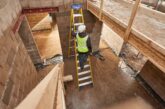
A new safety bulletin outlining the potential risks of using rooflight safety nets has been jointly published by The Rooflight Association and FASET, the Fall Arrest Safety Equipment Training association.
Safety netting has played an important role in the construction industry for many years. Usage of nets conforming to BS EN 1263-1 in underslung applications is supported by FASET as well as HSE (Health & Safety Executive) and ACR (Advisory Committee for Roofsafety).
However, more recently, The Rooflight Association has expressed concern regarding netting products which are being offered for use over rooflights, as a means of fall arrest in the event of a person falling onto a rooflight which may be classed as ‘fragile roof’. Some manufacturers’ installation instructions show nets being secured over out-of-plane rooflights by means of a ratchet strap to the upstand, or freestanding unfixed and unsecured temporary framework.
Mark Wilcox, Safety Representative for The Rooflight Association, said: “These practices are potentially a danger to life. Typical rooflight upstands are not designed, tested or attached to the roof in such way as to be able to provide reliable anchorage for a safety net or safey line of any kind.”
Anchorage points for roofwork safety nets must comply with the requirements of BS EN 1263-2 and BS 8411, and safety lines must comply with BS EN 795 and should be clearly labelled as such. Rooflights are rarely designed and tested to be used as anchorage points so should not be used for this purpose.

FASET Managing Director Tony Seddon, summed up: “This is an important safety issue which needs to be urgently addressed. Our ongoing collaboration with The Rooflight Association has resulted in the publication of this succinct bulletin, which provides a clear explanation of the potential dangers to avoid – to help keep roof workers safe.”







